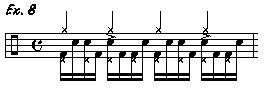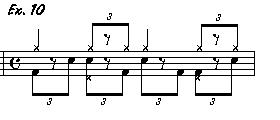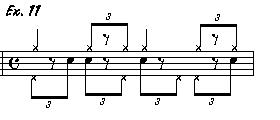One of the best drumset books ever written isn’t a drumset book at all.
It’s a book designed to develop snare drum technique. Nevertheless it
has become a staple of drumset pedagogy. The book I’m speaking of is Stick
Control by George Lawrence Stone. George Lawrence Stone was a prominent New
England drum instructor during the 1930's through the 1950’s. Perhaps
his most famous student was Joe Morello. Stick Control was first published
in 1935. To quote Stone, “It is an advanced book, consisting of a progressive,
highly concentrated collection of rhythms, arranged in calisthenic form, which,
if practised regularly and intelligently, will enable one to acquire control,
speed, flexibility, touch, rhythm, lightness, delicacy, power, endurance, preciseness
of execution and muscular co-ordination to a degree far in excess of his present
ability.” If practiced diligently it meets that goal admirably.
The remarkable thing about Stick Control is that it also meets a similar goal
when applied to the drumset. Stick Control has been adapted and used by
many teachers and players. Its practical application to the drumset is
limited only by the imagination of the player or teacher. What follows
is brief overview of some applications I have used. They are meant only
as suggestions. Explore the book and come up with your own variations.
For those of you unfamiliar with Stick Control it is primarily a collection
of sticking exercises. For example the first 3 pages go through many of
the sticking combinations available with eighth notes in 4/4 (or 2/2) time using
singles, doubles, triples, and quadruples.
Here are some examples of the types of stickings the book contains. This
is exercise 6 on page 5: (Ex 1)

Here is exercise 19 on page 5. (Ex 2)
 .
.
And here is exercise 43 on page 6. (Ex 3)

These stickings can be applied to the drumset in a variety of ways. One
practical application is to play all the R’s on the bass drum and the L’s with
either the right or the left hand. (Ex 4)

Practicing the stickings in this way provides useful exercises for developing
coordination between the bass drum and hands. After this becomes comfortable
try using alternating sicking. (Ex 5)

This will create excellent exercises for developing the bass drum as a solo
voice. It’s is also helpful in developing the coordination to play linear
patterns. A similar routine would be to practice as before, but play the
R’s on the hi-hat with the left foot. (Ex 6) Here again we are developing
a high degree of coordination between the limbs.

The preceding examples were useful in developing linear and solo ideas, but
Stick Control has just as much application in developing coordination as applied
to “time keeping.” For example the exercises can be played as rock patterns
by playing eighth notes on the hi-hat with the right hand, and then playing
the written part as sixteenth notes. All written “R’s” would be played by the
bass drum. The left hand would play all written “L’s” on snare drum. Often
times you can phrase the left hand so that 2 and 4 is accented to give it a
nice backbeat. (Ex 7)

To make it more challenging play the right hand on the ride cymbal, using quarters,
eighths, or sixteenths, and play the hi-hat with the left foot, using 2 and
4, straight quarters, or straight eighths. Play the “R’s” and “L’s” as
sixteenth notes. The bass drum plays the “R’s”. The left hand on snare
plays the “L’s”. (Ex 8)

Practicing the exercises in this way will provide a wealth of useful time keeping
and coordination material. To develop “touch” and control pick a few snare
drum notes to accent and play all others as ghosted notes (i.e. very softly,
½” from the head).
The exercises can also be used to develop what Bob Moses has dubbed the “dependent”
technique. In the dependent technique the bass drum and right hand are
played together (i.e., in unison). In other words all “R’s” are played by the
bass drum and right hand TOGETHER. Keep a straight-ahead pattern going with
the left foot on the hi-hat. All “L’s” would still be played on the snare
drum. This is great for unison coordination between your right hand and
right foot. (Ex 9)

The exercises can also be played with a jazz cymbal rhythm. Just remember
to interpret the eighth notes as “swung 8th’s”. (i.e. the 8th’s should
have a triplet feel). Play the “R’s” with the bass drum. Play
the “L’s” on the snare drum. The right hand plays the jazz cymbal rhythm.
Play 2 and 4 with the left foot on hi-hat. (Ex 10)

Instead of playing the “R’s” on the bass drum you can also play the “R’s” on
the hi-hat with the left foot. The “L’s” would still be played on the
snare drum. This is a great exercise for building up coordination with
your left foot (ala Tony Williams or Jack DeJohnette). (Ex 11)

These are just a few examples of how to use this great book. They barely
scratch the surface. This book is a classic, probably one of the top 10
drum books of all time. If you have never used it check it out.
Use your imagination and you will have thousands of hours of great material
to practice. Enjoy.

 .
. 







